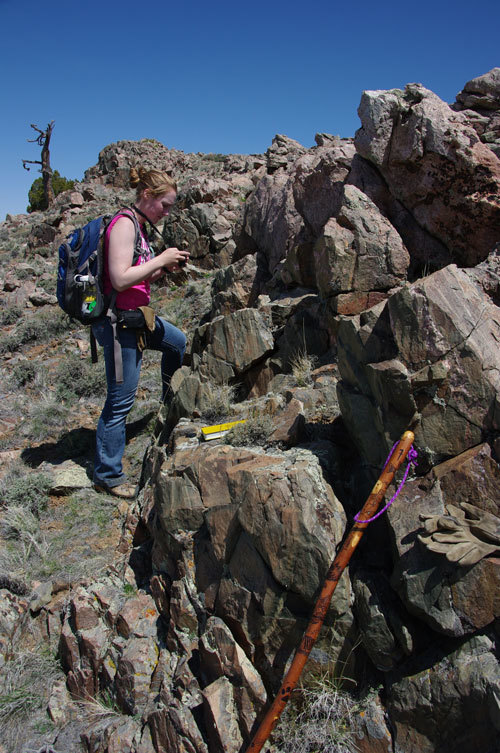NEWS RELEASE: WSGS Publishes Three New Geologic Maps
Wyoming State Geological Survey sent this bulletin at 09/30/2014 09:16 AM MDT |
|
Having trouble viewing this email? View it as a Web page. |
Sept. 30, 2014
******FOR IMMEDIATE RELEASE******
Media Contact:
Chamois Andersen
307-766-2286 x231
chamois.andersen@wyo.gov

Geologist Elizabeth Cola conducts research for the bedrock geology map for Mc Intosh Meadows, Fremont and Natrona counties, Wyo.
Wyoming Geological Survey Publishes Three New Geologic Maps
Geological maps are vital for land management and the exploration of Wyoming’s energy resources and minerals. The Wyoming State Geological Survey (WSGS) has recently published under its STATEMAP program one surficial and two bedrock geology maps available in digital formats or to order via the WSGS website.
• 1:24,000 scale Bedrock Geology of the Mc Intosh Meadows Quadrangle, OFR 14-2, Fremont and Natrona counties (including explanatory text of the study area)
• 1:24,000 scale Bedrock Geology Map of the North Ridge Quadrangle, OFR 14-3, Johnson County (including explanatory text of the study area)
“By creating geological maps we are able to understand the characteristics and structure of rock formations, along with other detailed information,” said Seth Wittke, WSGS geologist and STATEMAP project coordinator. “These maps are used to evaluate the potential for resource development
as well as to examine hydrogeology and geologic hazards.”
The WSGS maps were created at a scale of 1:24,000; 1 inch on the map is equal to 24,000 inches (2,000 feet or 609.6 meters) in the real world. The colors on the maps represent the different formations on the surface. The maps also show geologic structure and surface faults in the mapped area.
WSGS geologists responsible for mapping the Mc Intosh Meadows 7.5’ quadrangle (Fremont and Natrona counties) addressed the potential for occurrences of gold, rare earth elements, and iron, all of which have been the subject of exploration activity in the areas immediately east of the quadrangle. This investigation provided important geologic details in the area, including more accurate radiometric dates for previously unmapped Paleoarchean-Mesoarchean (approximately 3.3 bi
llion years old) rocks. With this new information geologists can gain a better understanding of central Wyoming’s Precambrian geology and structure.
Geologists for the North Ridge 7.5’ quadrangle (Johnson County) focused on mapping mineral and energy resources and also examined local hydrogeology and geologic hazards. This map includes the Clear Creek Thrust Fault, which can be seen along the Cloud Peak Scenic Byway. The geologists mapped additional splays of the fault south of Hwy. 16. West of the fault along Hwy. 16 is an ultramafic dike that the geologists dated to be as old as 2.68 billion years, approximately 200 million years younger than the surrounding gneiss. This is the first time these rocks have been dated.
“Gaining estimates of rock ages is important for establishing the history of geological events and for determining how the geology of Wyoming came to be,” Wittke said.
Wittke led the mapping efforts for the Chicken Spring area in Sweetwater County. His team focused on the Quaternary-aged fault system along with the surficial geology of the area. A WSGS report is being developed with the data gathered for this map project.
STATEMAP is funded through an annual competitive grant process under the U.S. Geological Survey (National Cooperative Geologic Mapping Program). Creating the geologic maps involved hundreds of hours of fieldwork, with geologists often hiking many miles for their measurements and rock samples.
“There is a lot of work that goes into producing these maps and fieldwork is key,” Wittke said. Geologists first compare their findings to other geologic maps and written materials covering the area to be examined. To generate the actual map the geologists then worked with the agency’s Geographic Information Systems (GIS) experts to take the information gathered in the field and incorporate the various layers of data on their maps.
The primary objective of STATEMAP is to establish the geologic framework of areas that are vital to the welfare of individual states. State Geologist and WSGS Director Tom Drean works with the agency’s geologists to determine the state's mapping priorities for this annual grant program. Each STATEMAP project focuses on a specific area or issue. “Although an individual project lasts for only one year, they frequently build upon and supplement the results of ongoing survey objectives and previous years' mapping activities,” Drean said.
The next round of STATEMAP projects under development include preliminary geologic maps of the Rawlins Peak SW and Shamrock Hills 7.5’ quadrangles (Carbon County) and a preliminary surficial geology map of the Afton 30’ x 60’ quadrangle (Lincoln and Sublette counties).
###
You are subscribed to All News Releases for Wyoming State Geological Survey. This information has recently been updated, and is now available.

